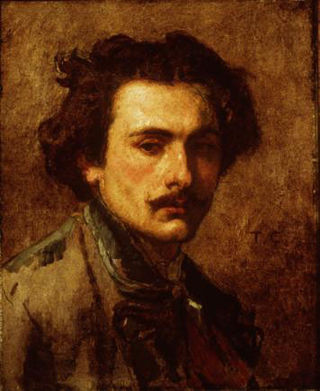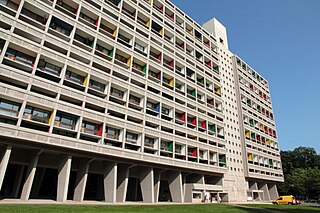
Georges Braque was a major 20th-century French painter, collagist, draughtsman, printmaker and sculptor. His most notable contributions were in his alliance with Fauvism from 1905, and the role he played in the development of Cubism. Braque's work between 1908 and 1912 is closely associated with that of his colleague Pablo Picasso. Their respective Cubist works were indistinguishable for many years, yet the quiet nature of Braque was partially eclipsed by the fame and notoriety of Picasso.

The national flag of France is a tricolour featuring three vertical bands coloured blue, white, and red. It is known to English speakers as the Tricolour, although the flag of Ireland and others are also so known. The design was adopted after the French Revolution; while not the first tricolour, it became one of the most influential flags in history. The tricolour scheme was later adopted by many other nations in Europe and elsewhere, and, according to the Encyclopædia Britannica has historically stood "in symbolic opposition to the autocratic and clericalist royal standards of the past".

Francis Picabia was a French avant-garde painter, poet and typographist. After experimenting with Impressionism and Pointillism, Picabia became associated with Cubism. His highly abstract planar compositions were colourful and rich in contrasts. He was one of the early major figures of the Dada movement in the United States and in France. He was later briefly associated with Surrealism, but would soon turn his back on the art establishment.

Thomas Couture was a French history painter and teacher. He taught such later luminaries of the art world as Édouard Manet, Henri Fantin-Latour, John La Farge, Pierre Puvis de Chavannes, John Ward Dunsmore, Karel Javůrek, William Morris Hunt, and Joseph-Noël Sylvestre.

Robert Delaunay was a French artist who, with his wife Sonia Delaunay and others, co-founded the Orphism art movement, noted for its use of strong colours and geometric shapes. His later works were more abstract. His key influence related to bold use of colour and a clear love of experimentation with both depth and tone.

Georges Charpak was a Polish-born French physicist, who was awarded the Nobel Prize in Physics in 1992.

Aimé Jacques Alexandre Bonpland was a French explorer and botanist who traveled with Alexander von Humboldt in Latin America from 1799 to 1804. He co-authored volumes of the scientific results of their expedition.

The Ashcan School, also called the Ash Can School, was an artistic movement in the United States during the late 19th-early 20th century that produced works portraying scenes of daily life in New York, often in the city's poorer neighborhoods.

George von Lengerke Meyer was a Massachusetts businessman and politician who served in the Massachusetts House of Representatives, as United States ambassador to Italy and Russia, as United States Postmaster General from 1907 to 1909 during the administration of President Theodore Roosevelt and United States Secretary of the Navy from 1909 to 1913 during the administration of President William Howard Taft.

Whitelaw Reid was an American politician and newspaper editor, as well as the author of Ohio in the War, a popular work of history.

Sir John Hall was a New Zealand politician who served as the 12th premier of New Zealand from 1879 to 1882. He was born in Kingston upon Hull, England, the third son of George Hall, a captain in the navy. At the age of ten he was sent to school in Switzerland and his education continued in Paris and Hamburg. After returning to England and being employed by the Post Office, at the age of 27 he decided to emigrate. He was also Mayor of Christchurch.

Albert Auguste Cochon de Lapparent was a French geologist.
Jeonse, also known as chŏnse, key money deposit or key money, is type of a lease or deposit common in the South Korean real estate market. Instead of paying monthly rent, a renter will make a lump-sum deposit on a rental space, at anywhere from 50% to 80% of the market value, which is then returned at the end of the lease term. The owners make profit from reinvesting the jeonse deposit, instead of receiving the monthly rent. It is also possible to combine a lower jeonse with a lower monthly rent.
Cochon is a French word that may refer to:

Alcyon was a French professional cycling team that was active from 1905 to 1959, and returned in 1961 and 1962. It was started by Alcyon, a French bicycle, automobile and motorcycle manufacturer.

Annual marches, protests or gatherings take place around the world for transgender issues, often taking place during the time of local Pride parades for LGBT people. These events are frequently organized by trans communities to build community, address human rights struggles, and create visibility.

Sir Matthew Smith, CBE was a British painter of nudes, still-life and landscape. He studied design at the Manchester School of Art and art at the Slade School of Art. Smith studied under Henri Matisse in Paris and acquired an interest in Fauvism. During World War I, he was wounded at the Battle of Passchendaele. In 1949, Smith was appointed a Commander of the Order of the British Empire (CBE). He was knighted in 1954.
Joseph Moisevich Chaikov was a Russian Imperial and Soviet Russian sculptor, graphic designer and teacher of Ukrainian Jewish descent.

The Unité d'Habitation of Briey is a housing unit built between 1959 and 1960 in Briey (Meurthe-et-Moselle) by the Franco-Swiss architect Le Corbusier according to the Unité d'habitation design principle established for Marseille. It was originally built for the HLM departmental office but was eventually abandoned by the landlord and threatened with destruction in the 1980s. It has since been gradually rehabilitated.















